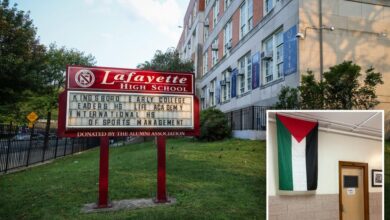‘Millennial saint’ Carlo Acutis remembered as 21st century boy

Two new saints will be canonized on Sunday in Rome — including the first-ever millennial saint.
The joint ceremony will be broadcast on Eternal Word Television Network [EWTN] and Vatican News channels beginning at 3 a.m. EST.
Celebrated by Pope Leo in St. Peter’s Square, it will honor two young men, Carlo Acutis and Pier Giorgio Frassati, who were not members of the clergy, but ordinary people doing extraordinary things for others.
Carlo Acutis, who died of leukemia at 15 in 2006, created a website to research and document miracles around the world, earning the nickname “God’s influencer.”
Pier Giorgio Frassati was 24 when he passed away, and will now be canonized 100 years after his death.
“For Catholics, saints have two main ‘jobs’: to intercede with God on our behalf, and to serve as good role models for us here on Earth. You can hardly find two better role models than our two soon-to-be saints,” The Archbishop of New York, Timothy Cardinal Dolan, told The Post.
“Blessed Pier Giorgio lived in the 20th century, was active in social justice causes, and loved being close to nature. Blessed Carlo … had a cell phone, loved video games, and built a guide to prayer and miracles on his computer.”
To become a saint, an individual must have performed two miracles after their death.
“Medical personnel have to investigate whether, in fact, what was healed actually existed, first of all, and then … whether the healing occurred because of some miraculous intervention by God,” explained Rev. Patrick Flanagan, chair of St. John’s University’s theology department.
One of the miracles attributed to Acutis was the 2013 healing of a Brazilian boy, Matheus Vianna. The youngster suffered from annular pancreas, a rare disease which caused difficulty eating and abdominal pain. But after kissing a relic of Acutis’ T-shirt, he was said to be cured.
A second, recognized in 2024, was the healing of Valeria Valverde — a 21-year-old university student with a severe head injury — after her mother prayed at Actutis’ tomb in Assisi, Italy.
Acutis, a native of London who was raised in Milan, was born into a wealthy family.
His father, Andrea, is a chairman of an insurance company and his mother, Antonia, worked in her family’s publishing business. Neither of his parents were religious, but Carlo, an only child, was devoted to the Catholic faith from a very young age.
“At just three years old, he was drawn to churches. He wanted to go inside them. My own faith at the time was lukewarm, but Carlo was deeply religious,” Carlo’s mother, Antonia Salzano Acutis, told The Post.
She added that he “began praying the rosary every day, by the age of five and a half.”
Sister Alessandra, Mother Superior of the Monastery of Perego of the Ambrosian Hermit Nuns, where Acutis received his First Communion in 1998, recalled the boy’s reaction to receiving the sacrament.
“Suddenly, he began to move as though he could no longer contain himself,” she told The Post. “It seemed as if something profound had happened within him — something great, something known only to him, and impossible to hold inside.”
Acutis, whose favorite cartoons were “The Simpsons,” “Pokémon” and “Dragon Ball,” played soccer, basketball and tennis, and his favorite sports team was AC Milan. He was a generous competitor himself.
“When we played Ping-Pong, he would say, ‘Take this paddle, it’s the best one,” Carlo’s grandfather, also named Carlo Acutis, told The Post.
He was equally generous with his worldly possessions, giving them away to people in more need.
“Whenever I gave him something nice, he would immediately pass it on to someone else,” Antonia recalled.
One of Acutis’ classmates, a young man named Mario, recalled his works of charity.
“He used to set aside part of his dinner each day to bring it to a homeless man who slept on the steps of his parish church,” he told The Post.
Carlo fell ill with flu-like symptoms in October 2006, and died only a few days after being diagnosed with acute promyelocytic leukemia.
His mother said he never cried while he was in the hospital.
“When doctors asked him, ‘Are you suffering?’ he answered, ‘Don’t worry. There are people who suffer more than me.’”
Frassati, meanwhile, was born in the northern Italian city of Turin in 1901, to a father who was a senator and the founder of the newspaper, La Stampa.
His devotion to helping others “started as a young boy, when a woman came to the door with a child with no shoes — and Pier Giorgio immediately … took off his shoes and socks and gave them to her,” Christine Wohar told The Post.
She founded FrassatiUSA, a nonprofit with the mission to “promote his spirituality” around the world.
“In his 20s, he came in one night in freezing temperatures and didn’t have his nice Italian overcoat. When his father asked him, he said he had given it away to a poor man. He would go into the poorest areas of the city, and brush the children’s hair.
“It’s a great story because Pier Giorgio had every reason not to be a saint,” Wohar said. “He had wealth, good looks, he was athletic, he had a chauffeur, maids, gardener, cooks, all of that. But he knew there was something more.”
In 1925, Frassati was stricken with polio, which he most likely contracted from working with the poor, and soon died from complications.
Eight years later, Domenico Sellan, 40, was cured of paralyzing spinal tuberculosis after a priest gave him a prayer card of Frassati. This miracle was recognized in 1990.
Like many others considered for sainthood, Frassati’s body was exhumed by the church in 1981, and his remains were found completely intact.
“The Roman Catholic Church does this to verify signs of holiness like incorruptibility — although incorruptibility is not required for canonization — … and [to] collect sacred relics, parts of the body or clothing, for veneration,” Flanagan explained.
Wohan recalled speaking to one of Frassati’s nieces, who was present when his body was exhumed.
“I had asked her, ‘When did you know there was something special about your uncle?’ And she said, ‘For me, I’m a doubting Thomas, but when they opened the coffin, he was perfect. The smile on his face.’”
It wasn’t until 2024 that Frassati’s second miracle was recognized.
In 2017, Juan Gutierrez was studying at St. John’s Seminary in Camarillo, California, when he tore his Achilles tendon. Stressed over what would surely be a long recovery and the expense of medical intervention, he set forth a novena — nine days of dedicated prayer — seeking Frassati’s intercession.
A few days in, Gutierrez recalled last year, “I was praying, and I started to feel a sensation of heat around the area of my injury. And I honestly thought that maybe something was catching on fire, underneath the pews.”
According to the Catholic News Agency, he was not only able to then walk without a brace, but the tear that had been visible on an MRI scan had disappeared.
Wohar said it is “very beautiful” that Gutierrez’s healing was recognized as Frassati’s second miracle “because the hardest thing, I’ve always heard, is to have miracles from the United States [confirmed] because it’s hard to get the doctors to credit God.”
One Long Island man credits Frassati for divine intervention, though his experience didn’t count towards canonization.
In 2011, Lynbrook native Kevin Becker was a senior at East Stroudsburg University when he fell 15 feet from a roof, fracturing his skull in five places and leaving him in a coma.
Acousin suggested the family pray a novena to Frassati and put his photo by Becker’s bedside at Lehigh Valley Hospital. Three days after they started praying, Becker opened his eyes.
Becker, now 35, recalled telling his mother: “There was an angel with me and he kept me safe.’ I see this young guy that I have never seen before in my life … He simply replies to me, ‘I’m your new roommate. My name is Giorgio,’” Becker told The Post. “I tried sneaking out on him [in the vision] and, as I get to the door, he touches me and he goes, ‘I’ll let you know when you’re ready to leave.’”
His mother proceeded to show him the photo of Frassati, which he had never seen before.
“I see the picture of Giorgio and I go, ‘That’s the son of a gun that wouldn’t let me leave my house.’”
Wohar, who is in Rome for the canonization, believes that Becker’s story pushed along Frassati’s canonization.
“My feeling is that Kevin was the pre-miracle miracle,” she said, adding that she gets many letters from others who credit Frassati for their healing.
The process of canonization, which begins with a grass-roots process by devotees, can be pricey, according to Flanagan. “There is a multitude of personnel involved including academics, scientists, medical personnel, translators … and other skilled technicians. It has been reported that the average costs are around $250,000 to $500,000.”
Although not precisely known, the number of Catholic saints is predicted to be nearing 11,000.
Becker, who will watch the ceremony with fellow members of the Frassati Young Adult Group of Our Lady of Lourdes Church in West Islip, Long Island.
“There’s a lot of people out there that have been praying for this moment,” he said. “We’re part of something that we had no clue if we would have been alive for.”
Credit to Nypost AND Peoples



